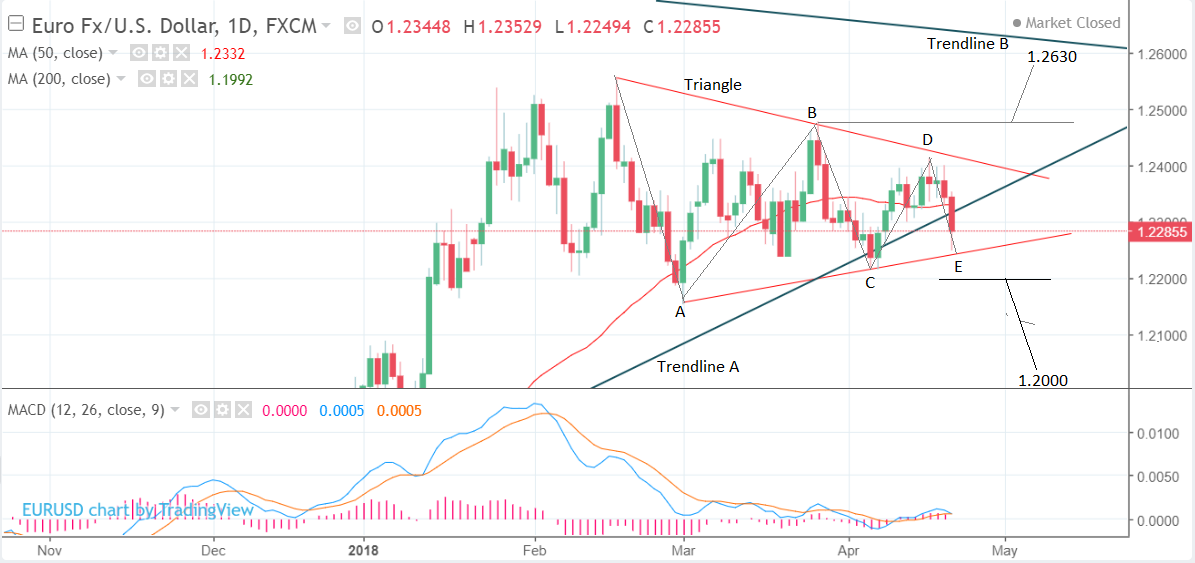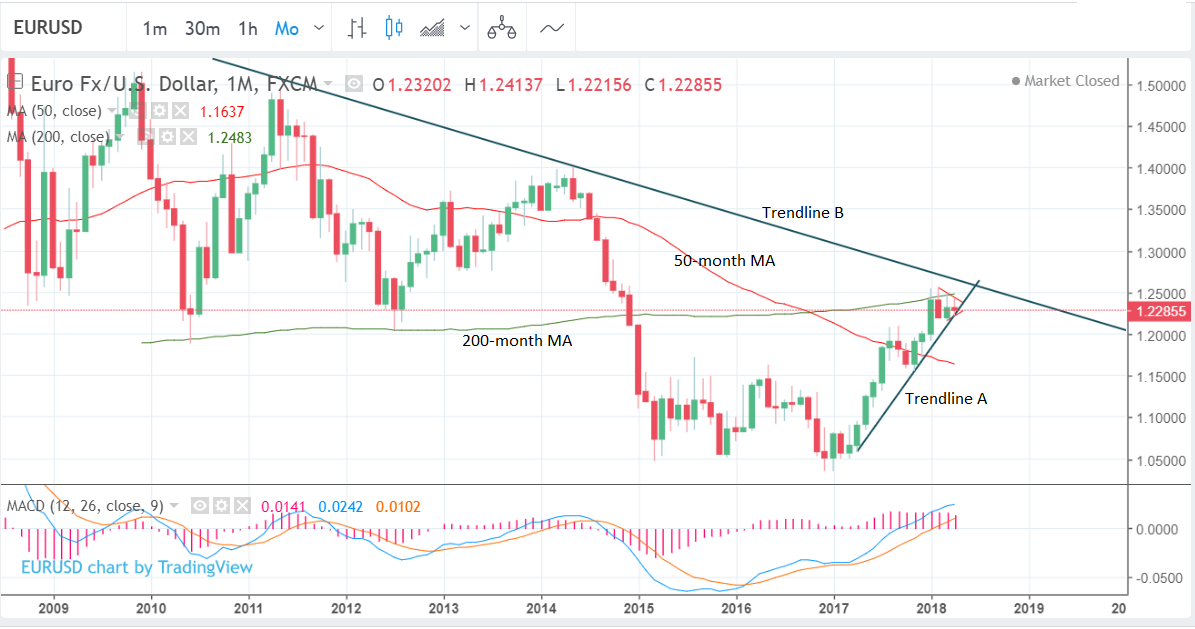The Euro-to-Dollar Rate's Forecast For the Week Ahead
- EUR/USD looks poised to breakout after months of sideways market behaviour
- The main event for the Euro in the coming week is the meeting of the European Central Bank
- The Dollar's main release is first quarter GDP growth

© thanasak, Adobe Stock
After months of plateauing EUR/USD may be on the verge of a new dawn of volatility.
The Euro-to-US Dollar exchange rate seems to have found its 'equilibrium' rate in the early 1.20s having spent most of 2018 oscillating in a narrowing range between highs of 1.25 and lows of 1.21.
Probably the more vulnerable to breakdown is the Euro (ergo EUR/USD lower) because the Eurozone has seen such a dramatic drop off in growth over recent months.
From a technical perspective, the charts indicate that the period of equilibrium may soon reach an end and will probably be followed by a period of high volatility.
This is due to the fact that the 1.21-25 range has actually been tapering to a narrowing apex, forming into the shape of a triangle, and these sorts of patterns often herald volatile breakouts (see chart below).
The chart above shows the triangle pattern we are talking about. It is composed of five component waves, labeled A-E, which is the minimum number required for completion. This suggests, therefore, the pattern is probably finished, or almost finished.
Once complete, triangles normally breakout strongly in one direction or the other. In the case of this triangle it is hard to predict which way price-action will break as there are arguments in favour of both an upside breakout - such as the fact the pair was in an uptrend prior to going sideways - and also a downside breakout, such as the fact that the price has now successfully broken below the uptrendline (trendline A).
A break above the B-wave highs at 1.2476 would confirm a move up to a target at 1.2630; a break below the 1.2200 level, on the other hand, would confirm a break down to 1.2000.
The distances for these breaks correspond with golden ratio (0.618) of the height of the triangle at its tallest, extrapolated higher and lower from the break.
News and Data to Watch for the Euro
From a data perspective, the main event in the week ahead for the Euro is probably the policy meeting of the European Central Bank (ECB) on Thursday 26 at 12.45 GMT.
ECB monetary policy oils the wheels of financial liquidity in the region and is thus an important variable in the valuation of the Euro.
The ECB has already reduced its quantitative easing (QE) programme substantially because of the strong recovery in the region, which means it does not need the excess liquidity provided by QE, and this has been positive for the Euro.
The central bank is now waiting for further confirmation the region is healing before ending the programme completely.
At the moment it does not plan to make any major changes until the second half of the year so no major policy changes are expected at the meeting.
The devil will almost certainly be in the detail, therefore, and analysts will be busy combing the ECB's official statement for hints, amendments or omissions pointing to a change in the policy trajectory or timing.
"A key question is whether we get any further clues from the Governing Council on how it views the Q1 softening in economic data and whether it sees this as a slowing in growth momentum or a blip, and also how this might sway the policy stance going forward," says Investec's Ryan Djajasaputra.
The view is shared by analysts at Canadian investment bank TD securities:
"We look for patience & prudence from the ECB, with little new from the Governing Council aside from acknowledgment that recent activity data has softened a little," they say, adding, "but that it should not affect their medium-term forecast."
Nordea's Andreas Steno Larsen, meanwhile, thinks the ECB will probably sound a little more dovish on account of the recent run of poor economic data results for the region but refrain from "changing forward guidance".
"While Draghi's tone should be relatively dovish. We do not expect the ECB to change its forward guidance until the July meeting unless the next few inflation figures surprise to the upside," says Larsen.
A 'dovish' sounding ECB - i.e. the striking of cautious tone - would most likely weigh on the Euro.
The other main releases for the Euro are Manufacturing and Services PMIs for April, out on Monday at 9.00 - indeed these may even colour the ECB's rhetoric, depending on their outcome.
PMI's are survey-based metrics which gauge sector activity levels.
Manufacturing PMI is forecast to remain unchanged in April at 56.6, whilst Services is expected to decline to 54.6 from 54.9 previously; the Composite is forecast to 54.9 from 55.2.
Given recent sharp falls in PMI's since the start of 2018, a further decline would not come as a surprise, and the unchanged Manufacturing figure almost looks marginally optimistic.
"There's a risk PMIs declined further in April," says Andreas Steno Larsen, analysts at Nordea bank, adding, "The currency remains strong, which coupled with continued uncertainty about a trade war could have weighed on sentiment in Manufacturing industry in April."
Data and Events to Watch for the US Dollar
For the Dollar the week ahead is bookended by the two most important data releases, starting with survey data for the Manufacturing and Services sectors (PMIs) on Monday and Q1 GDP growth rate on Friday.
PMI is short for 'Purchasing Manager Index' and is a score calculated from the responses of managers with pivotal roles within a sample of organisations in a given sector. PMIs are viewed as useful early indicators of broader economic trends; a score above 50 is indicative of expansion, and below of contraction, in the sector.
Both the US Manufacturing and Services PMIs for April are out at 14.45 GMT on Monday, April 23. Manufacturing is forecast to decline to 55.2 from 55.6 in March, but Services is forecast to rise to 54.3 from 54.0 in the previous month.
A higher PMI is seen as bullish for the buck.
The other major release for the Dollar is the preliminary release of Q1 GDP, out on Friday, April 27 at 13.30.
Expectations are for growth to rise by 2.0% quarter-on-quarter (qoq) - on an annualised basis (ie over the last 12 months or year) - compared to 2.9% in Q4.
These general expectations are seen as an over-optimistic by Canadian Investment Bank TD Securities, who expect a slower pace of growth.
"We expect the advance estimate to confirm another disappointing Q1 near an on-trend pace of 1.6%. The main source of weakness is consumer spending (1.1%) but the trade will also be a drag," says TD Securities.
Nordea Bank's Andreas Steno Larsen, in contrast, is more bullish, forecasting 2.9% growth in 2018 as a whole, which would seem to suggest a not too low result in Q1 for there not to be a lot of catching up to do in the later Qs, however, Larsen also cautions against getting too focused on Q1 figures, which are "always weak" anyway, "so don't get too worried about the health of the US economy."
Get up to 5% more foreign exchange by using a specialist provider to get closer to the real market rate and avoid the gaping spreads charged by your bank when providing currency. Learn more here.






